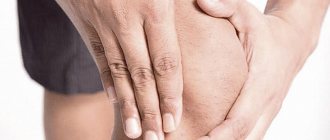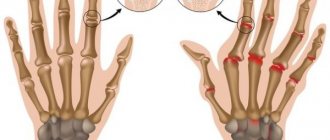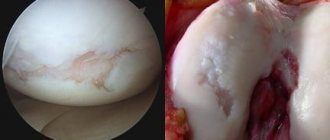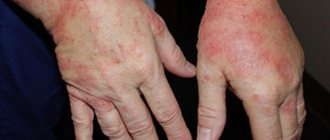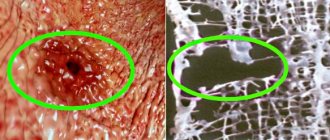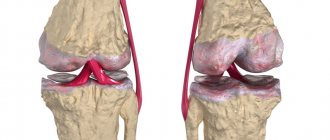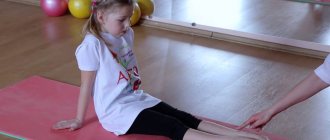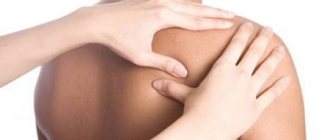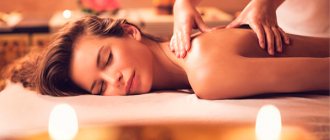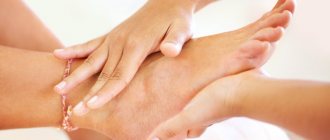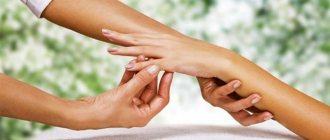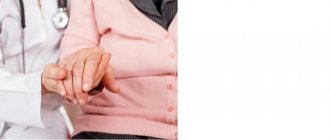2002The information is for reference only. Do not self-diagnose or self-medicate. Contact your doctor .
Arthritis is an inflammatory process that affects a specific group of joints. In the general course of treatment for arthritis, massage is an important component, which allows you to achieve positive dynamics of the disease, cope with attacks of pain and stiffness in movement, and swelling in the joint area.
Allowed methods and correct massage techniques for arthritis will be discussed further.
Purpose and benefits of massage
When diagnosing remission during arthritis, doctors allow the practice of massage sessions, the purpose of which is:
- elimination of attacks of pain and stiffness in the affected joint itself;
- restoration of normal blood flow and lymph in the affected areas;
- prevention of muscle fiber atrophy.
As doctors note, the sooner a course of massage is prescribed, the better for the patient himself, since it will make the treatment itself more effective and efficient.
During rehabilitation, the massage course is at least 5 sessions, if arthritis is chronic, then at least 15, the duration of massage for each of the affected joints is at least 15-20 minutes.
A massage course helps:
- prevent atrophic processes in muscles, ensuring the supply of oxygen to the fibers of muscle tissue;
- helps to reduce or completely remove an attack of pain;
- stimulates the natural removal of effusion - biological fluid that has accumulated in the cavity of the affected joint;
- helps fight congestion and salt deposits in joints;
- improves blood circulation, normalizing it, and allows you to speed up the entire metabolic process in the massaged, affected area;
- restores and improves joint mobility impaired by disease.
Types and techniques of anti-arthritic massage
In the process of treating arthritis, a massage therapist can use both segmental and acupressure types of therapeutic massage. With a segmental type of massage, the massage therapist works on a specific segment of the patient’s body – the elbow, shin, thigh or shoulder joint.
Acupressure is based in its action on physiological processes - in this case, the massage therapist works on certain active points on the body. This is how it affects the nervous system and blood flow, improves the functioning of the internal glands, eliminates pain and muscle spasms.
In addition, depending on the area of the body involved in the massage, it is conventionally divided into the following types:
- Why is finger exercises necessary for arthrosis of the hands?
- Partial or local type of massage - in this case, the specialist massages a small area. Most often this is the area of the back and arms, the shoulder joint.
- General type of massage - in this case, the specialist works on the entire body, its entire surface. This type of massage can be performed every day or according to a different schedule drawn up by the attending physician.
Before starting a massage session, the attending physician is obliged to diagnose the form of arthritis, its location and extent of damage, and the severity of the disease. The following methods and techniques are used:
- If the joint is completely or partially immobilized, the massage therapist uses massage techniques such as stroking and rubbing, vibration . It is recommended to repeat each of the techniques at least 15-20 times, then moving on to warming up the affected joint and the surrounding area.
- The mobility of an arthritic joint can be significantly improved through a technique such as kneading with the edge of the palm or the pads of the fingers . Warming up the muscle fibers can be done by simply shaking the limb and after that you should proceed to a massage session.
- With acupressure massage, the impact on active points is permissible, both in a massage room and at home - in this type of massage, the fingertips are mostly involved. The duration of each impact is 10-15 seconds, which allows you to effectively relieve pain and improve metabolic processes in the affected joint, restoring its mobility.
Children's therapeutic massage of palms and fingers
Most often, doctors prescribe therapeutic massage of the palms and fingers for children from 0 to 3 years old. With its help, it is possible to develop fine motor skills, eliminate muscle tone and even influence the speech center.
There are several massage techniques and exercises with which a baby or older child can get everything they need for full growth and development.
This type of treatment can be carried out in two ways. The first involves pressing on the palm and each finger with the mother's hand. This effect is carried out in stages. At least 2-3 minutes are allocated for each stage. The sequence of performing a massage aimed at reducing muscle tone is as follows:
- Kneading. Targeted at muscles. Effortlessly produced.
- Tingling. It is performed over the entire surface of the palms and fingers, capturing the skin between the hands.
- Stroking. Involves light sliding movements to smooth out skin folds.
- Gentle stroking. Involves sliding movements of the fingers along the inside of the palm.
- Tweezers. This is pinching with massage of the fingers separately and stroking the skin
The second option involves the baby performing exercises together with the mother. You can use a special silicone ring with spikes and pimples for this. In addition to the ring, you can use a massage ball. This technique is simple only at first glance. When using it, every necessary point on the palm is involved.
A targeted impact using a spiked ball can be applied not only to the palm. In this way, the leg (foot) can be massaged with tone or mild forms of cerebral palsy.
Massaging all affected joints step by step
When diagnosing arthritis, a massage session begins with a direct influence on the hands, the back of it - the massage therapist performs each technique in an upward direction, following from the tip of each finger to the wrist joint.
At the very beginning of the impact, all massage techniques are carried out on intermediate bones and joints - this can be stroking and rubbing, straight or in a circle. In this area of the body, the massage therapist performs a massage with the pads of the thumb or with all fingers, by rubbing with the edge of the palm, or by doing some kind of improvised sawing.
For arthritis of the fingers, the specialist performs impromptu stroking, then massages each joint with straight-line or zigzag movements, using the pads of the fingers or the very base of the palm. To finish, shake your hand several times.
When diagnosing arthritis of the hip joint, the specialist first massages the lower part of the back and buttocks, then moves on to the joints and hips.
In the area of the lumbar and sacral spine, massage is carried out using movements such as stroking and kneading with the pads of the thumb and the back of all 4 other fingers.
If the patient tolerates the session itself well, then techniques such as rubbing, squeezing, and pinching can be introduced. With a gradual transition to the buttock area, massage techniques such as stroking and squeezing are used, kneading is also allowed - circular and zigzag, straight with the pads and knuckles of the fingers.
If the hip joint is affected, methods and techniques can be used around it such as careful stroking, shallow in strength and intensity, rubbing - in this regard, the entire palm and pads, as well as the back of the fingers, are used.
For arthritis of the knee joint - at the very beginning, the massage therapist exerts a paravertebral effect using stroking and rubbing, moving from top to bottom, from the lower leg area, ending the session with a gentle shaking of the leg.
- Massage for arthritis: benefits and contraindications, general rules and nuances of the procedure for rheumatoid arthritis
In case of damage to the joints of the feet, the specialist practices the use of deep stroking, moving the pads of the fingers in the direction from the fingers of the lower extremities and up to the ankle, and up to a third of the lower leg itself.
Foot massage is carried out not only with the pads of the fingers, but also with the entire surface of the palm.
Massage for arthritis and arthrosis
for arthritis and arthrosis
For diseases of the musculoskeletal system, therapeutic massage techniques effectively complement other conservative and surgical measures. Massage sessions have a pronounced effect on the pathological process in the joints and promote a speedy recovery of working capacity. For joint lesions of various natures, therapeutic massage should be started as early as possible in order to prevent the possibility of developing complications, for example, stiffness or ankylosis. It should be remembered that in the acute period, when swelling and redness of the soft tissues are observed in the joint area, and the body temperature is locally elevated, massage is contraindicated.
The mechanism of the therapeutic effect of massage
Despite the fact that massage techniques directly affect the area of the affected joint, during the session there is a complex effect on the entire body. With the correct massage technique, blood circulation in the joint area, as well as in the surrounding soft tissues, improves. Reflex muscle spasm is relieved, which leads to a reduction in pain and elimination of stiffness. As a result, the range of motion in the joint is gradually restored and normal muscle tone increases.
Activation of blood and lymph circulation processes contributes to the resorption of inflammatory exudate, in addition, there is a general improvement of the body and strengthening of its own defenses.
Indications for massage for joint diseases
Massage is indicated for conditions such as:
- deforming arthrosis associated with metabolic disorders in the body;
- chronic arthritis of nonspecific nature (rheumatoid);
- deforming arthritis resulting from microtrauma of the joint.
Depending on the type of affected joint, a certain sequence of massage techniques should be followed.
- Arthrosis of the joints of the hands. In this case, the massage begins from the back of the hands, performing movements in the direction from the fingertips to the wrist joints. Rubbing is used, as well as various types of stroking, including rubbing with the edge of the palm. Each finger should be worked separately: stroking is followed by rubbing (zigzag straight, with the base of the palm), and the procedure is completed with gentle shaking.
- Arthrosis of the hip joints. The massage covers the lower back, buttocks, affected joint area and thighs. For the lumbosacral region, stroking, kneading with fingertips, squeezing and pincer rubbing are used. Moving to the area of the affected joint, they proceed to careful shallow rubbing, mainly in a circular motion.
- Arthrosis of the knee joint. In this case, the technique is similar to that described above: first they work on the lower back and thigh, and then carefully move to the knee area.
- Arthrosis of the shoulder joint. The preparatory stage includes warming up the muscles of the upper shoulder girdle, then stroking and shallow rubbing of the sore joint, after which the shoulder muscles are massaged with voluntary movements.
The massage of each area is completed with stroking, gentle tapping and patting.
The duration of a massage session for joint diseases is from 10 to 25 minutes. The greatest effectiveness is observed when conducting sessions 2-3 times a week, and the duration of the course depends on the rate of positive dynamics of the pathological process in the joints. Timely inclusion of massage in the complex treatment of joint diseases ensures a reduction in the rehabilitation period and restoration of a person’s ability to work in the shortest possible time.
You can learn massage techniques for arthritis and arthrosis at massage courses in Ufa at the Zheber massage school.
General tips and tricks
During the massage process, you should adhere to certain rules and tips. At the very beginning, it is worth considering that all movements should not cause pain or discomfort, be it a self-massage session or one performed by a specialist.
The optimal movements are smooth, but quite energetic, carried out measuredly and rhythmically - after them, in the area of the massaged area of the body there should not be pain, but a feeling of warmth, relaxation, ease of movement.
When performing a massage, it is prohibited to massage the lymph nodes, and the position during the session for the patient should be as comfortable as possible so that the body, muscles and tendons are relaxed.
When diagnosing problems with the musculoskeletal system, all manipulations begin in a top-down direction, covering the area above the affected area of the body.
In case of exacerbation of the pathology, massage is not performed, as well as when diagnosing inflammatory processes that occur in the body, in case of bleeding, if open wounds and purulent formations are diagnosed, and so on.
Each massage session is carried out exclusively with clean, pre-washed and warm hands. During the massage process, you can use special creams and gels that enhance the effect of massage movements.
Therapeutic massage for diseases of the musculoskeletal system
Therapeutic massage for injuries and diseases of the musculoskeletal system is a simple and at the same time the most effective means of rehabilitation. Its use is due to the physiological effects it produces on the human body. As a result of medical massage, the mechanical energy of the massage therapist’s hand is converted into the energy of neuro-reflex excitation. The impulse is transmitted to the central nervous system through receptors located in muscles, tendons, joint capsules, vascular walls and internal organs. All this allows you to achieve the desired results.
Therapeutic massage for injuries.
Therapeutic massage helps reduce pain, swelling, normalize the functions of joints and muscles, and prevents the development of adhesions leading to the formation of contractures. By increasing blood circulation and lymphatic drainage, tissue nutrition is improved, callus growth is accelerated, tissue regeneration processes are stimulated and muscle tone is restored. Massage is indicated for bruises, muscle and tendon sprains, and injuries at all stages of healing. The high effectiveness of therapeutic massage has been proven for delayed healing of fractures, for functional disorders, after dislocations, and for nonspecific joint diseases in the subacute and chronic stages.
Features of medical massage for injuries
Classic therapeutic massage performed for injuries of the musculoskeletal system is divided into two types: preparatory and main. The preparatory massage is done on undamaged areas of the body and begins with light strokes. After the patient gets used to it, they move on to more intense, but not painful, manipulations. Having completed the first preliminary massage sessions, you can begin the main stage. It is started when the patient’s pain disappears and tissue swelling decreases. It is advisable to prescribe medical massage using therapeutic, warming ointments that have a healing effect. All this leads to rapid restoration of the functions of joints and ligaments.
Therapeutic massage for poor posture
We are accustomed to perceiving poor posture as a purely aesthetic problem. How many of us have thought about the consequences of a stooped back, a crooked neck or a curved lower back? And how to correct the situation with incorrect posture?
In childhood and adolescence, the best way to cope with these problems is therapeutic massage. The procedure is prescribed by an orthopedic traumatologist or physiotherapist after examining the child. The massage is performed by specialists with medical education and is carried out in courses of ten sessions, 4 times a year. It is the massage therapist, by acting on the muscles, who is able to stretch and relax the shortened, tense muscles on the concavity side of the spinal arch and stimulate the stretched muscles on the convex side. All procedures must be carried out under the constant supervision of an orthopedist. If necessary, an additional examination by a chiropractor is prescribed. Massage should be combined with physical exercise, physiotherapeutic procedures, exercise therapy complexes, and swimming.
The integrated approach practiced by the doctors of Posture Clinic LLC in the treatment of impaired posture allows one to achieve good results if the patient’s deviation angle does not exceed 20-30 degrees.
Massage for flat feet
Flat feet are the most common disease of the musculoskeletal system. Therefore, if your child has a hereditary predisposition or is suspected of having flat feet, you should consult an orthopedic doctor. At the medical office, you can find out how often children’s massage courses are conducted for flat feet, what exercises need to be performed to prevent it, and what auxiliary measures help.
Effects of therapeutic massage
Various massage techniques can reduce or increase the excitability of the central nervous system, improving its functional ability, enhancing its regulatory and coordinating function. Massage accelerates regenerative processes and processes of restoring the function of damaged peripheral nerves.
Among other things, during the session positive emotions arise in the form of improved overall well-being, a pleasant state of peace, freshness, lightness and tranquility.
Depending on the existing problem, the procedure time ranges from 15 to 45 minutes, the course of treatment lasts 5-10 sessions, a second course of treatment is recommended after 3-4 months. Massage should be combined with physiotherapeutic procedures, exercise therapy, active and passive exercises.
Therapeutic massage is a medical procedure and requires prior consultation with a medical specialist. There are absolute and relative contraindications: fungal and pustular skin diseases, acute respiratory diseases, acute arthritis, hemarthrosis, cancer, thrombophlebitis, trophic ulcers, acute gynecological diseases, active form of tuberculosis.
LLC "Posture Clinic" is located at Orenburg, st. Spacious 19/2.
The clinic treats diseases of the musculoskeletal system, rehabilitation after operations on the limbs, joints and spine.
Types of treatment: Manual therapy, therapeutic massage, electrical stimulation, orthopedic consultation, selection of physical therapy complexes.
The cost of therapeutic massage can be found in our price list and by phone: 8(3532) 512779, +79033679906
Contraindications and restrictions
Despite all the benefits of therapeutic healing massage as a method of treating arthritis, it can also cause harm to the body and affected joints.
- Arthritis of the joints of the fingers and toes - symptoms, causes, treatment methods
Doctors include the main contraindications:
- acute inflammatory process occurring in the body at the time of the massage session;
- if the patient’s general health has deteriorated sharply;
- there is a violation of the ability of blood to clot, the body temperature is elevated, a fever of unknown nature and theology is diagnosed;
- there is an exacerbation of a chronic disease, which is accompanied by attacks of nausea and vomiting;
- You should not perform a massage session after excessive physical exertion or emotional stress;
- if the patient has severe pain;
- the skin is affected - open wounds, purulent rashes, ulcerative lesions of the dermis.
Absolute contraindications include problems with the liver and kidneys that are at the stage of decompensation, if the patient has sexually transmitted diseases, or in the case of an acute form of myocardial infarction.
Massage is not performed in case of mental disorder or problems with the central nervous system.
Regarding the local type of massage session, it is not recommended for patients who have been diagnosed with urolithiasis, as well as an inguinal hernia, during the menstrual cycle in women.
If a woman is pregnant, then it is strictly forbidden to massage the abdomen, hips, or lumbar region.
Self-massage technique for arthritis
When diagnosing arthritis, massage sessions can be carried out independently. In this case, the main advantages of self-massage are the following:
- it can be carried out in any position convenient for the patient - be it lying on the floor or sitting in a chair, and if you perform the procedures in a bathhouse, this will only enhance the effectiveness of the therapeutic massage session;
- The sessions themselves at home can be carried out at a time convenient for the patient, combining with physiotherapy.
The disadvantages of self-massage sessions are:
- it does not help to fully relax the muscles;
- in some parts of the body it is impossible to massage due to inaccessibility - back, shoulder;
- in the absence of sufficient practice and knowledge, you can do more harm to yourself than good.
How to properly conduct a self-massage session
If you do everything correctly, a self-administered massage will not cause discomfort or pain, or injure the dermis, leaving bruises or bruises on the body. The patient will only feel warmth at the massage site.
When performing self-massage, you need to start treating the area of the body that is located above the joint affected by the disease, also involving neighboring areas of the body.
Regarding the time frame for the massage - if the hand is being massaged, then it should take from 3 to 5 minutes, when massaging larger areas of the body - about 25-30 minutes.
In the process of self-conducting a massage session at home, it is important to take a comfortable position, while in the process of performing massage techniques it is necessary to take into account the direction of the lymph flow, moving in the direction of nearby nodes. At the same time, massaging them is strictly prohibited.
Self-massage, as well as a session performed by a specialist, is not carried out during the period of exacerbation of arthritis, and also if the skin in this area is damaged, there is an open wound or purulent neoplasms. It is in this case that it will be useful.
Taking into account the benefits of massage when undergoing a full course of treatment for arthritis, we can talk about its mandatory inclusion in the list of not only the therapeutic component, but also as an effective and efficient stage of rehabilitation. When carried out correctly, it will bring significant health benefits, restoring joints and returning the patient to a full life.
Arthritis of the fingers is a deforming, inflammatory disease that is localized in the small joints of the hands. Typically these are the interphalangeal and metacarpophalangeal regions. It is diagnosed more often in women, but the risk group includes all people over 45 years of age.
Self-massage for arthritis of the hands
Therapeutic massage of the palms and fingers for a disease such as arthrosis is not a panacea. But the patient’s further well-being largely depends on it. For arthritis in acute stages, as well as during observation of the patient in a hospital, massage is performed by a specialist strictly according to the doctor’s indications.
During the period of remission, the patient can independently perform self-massage at home.
It starts with tapping. With your hand relaxed, tap on a hard surface. This could be the floor or countertop. After this, you should thoroughly rub your hands one against the other. This manipulation should take an average amount of massage time - from 2 to 4 minutes. Then you need to rest your right palm on the tabletop, and with your other hand raise your fingers and make rotational movements with them from left to right. The left thumb should be on the outside of the right hand, and the rest will tightly clasp it on the inside. Then you should repeat the manipulations, changing hands.
The next stage of self-massage should be performed as correctly as possible. This is necessary in order to effectively use each joint. Both hands must be rested on a hard surface and rotated simultaneously with each finger. The correct fit is also important. I follow my back
Can't rest against the back of a chair or wall. When performing self-massage for arthritis, you can also use stroking, pinching and kneading techniques. All of them are aimed at reducing pain.
Causes of the disease
Causes are divided into primary and secondary. Primary causes are diseases that directly affect the articular surfaces:
- Rheumatoid arthritis is an autoimmune degenerative joint disease.
- Traumatic lesions (dislocations, fractures).
- Diseases associated with metabolic disorders (gout).
Secondary causes are associated with general somatic pathology, which resulted in complications in the joints:
- Allergic reactions.
- Tuberculosis (atypical course).
- Stage I diabetes mellitus (usually affects the lower extremities).
- Psoriasis (in severe forms).
- General infectious diseases (flu, herpes).
There are a number of reasons that are associated with this disease:
- elderly age;
- hypothermia;
- heredity;
- mechanical form of labor (seamstresses, office workers).
Arthritis of the thumb is included in a separate group. It is associated with both wear and tear of the cartilaginous part of the joint and aseptic inflammation. The lesion is predominantly in the metacarpophalangeal joint. There is a clear impairment of motor activity and a pronounced decrease in work activity.
Pathogenesis
The pathogenesis involves the destruction of articular surfaces in small joints and disruption of normal motor ability. The peculiarity of pathogenesis is determined by the reasons that caused the disease. For example, an infectious agent (bacteria, viruses), entering the joint cavity, begins to rapidly divide. Fluid accumulates in the joints (waste products of the pathogen, dead leukocytes), which leads to deformation of the fingers. The bone and cartilage structures themselves are destroyed not under the influence of the pathogen, but due to increased pressure on the articular surfaces.
Localization of the disease
Degrees and types of disease
Depending on the location of the lesion, the following types of arthritis are distinguished:
- proximal;
- average;
- distal;
- total.
Classification of the disease depending on the cause that formed the basis of the disease:
- Post-traumatic. It occurs as a complication of fractures and dislocations. Often occurs in professional athletes.
- Infectious. Hematogenous, lymphogenous or contact penetration of the pathogen into the joint.
- Reactive. The patient has a history of infections from the intestinal or genitourinary system (2–4 weeks before the joint was affected). Arthritis acts as a complication of the underlying disease.
- Metabolic disorder - gout. Deposition of uric acid salts in the cavities of small joints and, as a result, their inflammation.
Clinical picture
Arthritis of the fingers, unlike many other types, has pronounced symptoms from the first days. Chronic and subacute forms of this pathology are less common than acute forms. Clinical symptoms:
- Abrupt onset of the disease. High body temperature rises (more than 38 degrees), general weakness, headache.
- Local pain in the affected area. Sometimes several articular surfaces are involved in the lesion.
- Local hyperemia, edema, severe redness of the joint.
- Deterioration of finger mobility (decreased active and passive movements).
- Limb deformity. Occurs in chronic forms of the disease.
The disease has pronounced symptoms.
The clinical manifestation of carpometacarpal arthritis of the thumb has its own characteristics. Local manifestations appear on the 4th–5th day. Until this point, the main symptom of arthritis of the fingers is pain and limited mobility. Hyperemia and swelling are localized on the wrist and pain radiates to the forearm. The grip strength of the hand decreases sharply, as does the ability to perform usual actions.
Recommendations that need to be followed simultaneously with classes in the gym
To consolidate the effect obtained from exercise therapy, you must follow certain recommendations:
- wear a stable heel of 3-5 cm, additionally using a cane, knee pads or orthopedic insoles to maintain optimal load on the musculoskeletal system;
- sleep without a pillow using a medium-hard mattress;
- do short warm-ups every 30 minutes (without making sudden, jerky movements) to avoid long stays in a fixed position;
- Keep your back straight when using a computer, steering wheel or desk, using a corset if necessary.
Traditional treatment
The following specialists treat the disease:
- rheumatologist;
- neurologist;
- traumatologist;
- in small towns and villages a general practitioner or general practitioner.
Depending on the form, degree and clinical manifestations, treatment is carried out:
- FAP;
- outpatient clinical level;
- central district hospitals;
- Republican centers.
If arthritis is caused by concomitant diseases, then you should contact an appropriate specialist and undergo a course of treatment for the underlying pathology. This can be not only a rheumatologist, but also an infectious disease specialist, an immunologist.
Goal of treatment:
- restoration of motor activity;
- relieving inflammation;
- pain relief and return to normal quality of life;
- restoration of deformed areas of the limbs.
Medication
Drug treatment is the main and mandatory component of a doctor’s prescription. The doctor individually selects the course of treatment. In the absence of visible clinical improvements, the drug is changed on day 5.
Drugs
The first goal in treatment is to combat the inflammatory process, so the following drugs are included:
- NSAIDs. Classic prescription for all aseptic inflammations of the joints. Penetrating into the joint, it has three types of effects at once: antipyretic, analgesic and anti-inflammatory activity. Example – “Ibuprofen”, “Diclofenac”.
- Painkillers relieve the main symptom of the disease - pain. An example is “Analgin”.
- Antibiotic therapy to eliminate the pathogen. Example - "Ciprofloxacin", "Amikacin".
- Corticosteroids in cases where there is no positive improvement for a long time.
- Chondroprotectors to protect the cartilaginous components of the joint from further damage.
- Vitamin complexes containing calcium, phosphorus and collagen, as well as B vitamins.
Often pronounced pain in the joints leads to sleep disturbances. In this case, it is acceptable to prescribe sleeping pills of a new generation that are not addictive (Zaleplon, Zopiclone, Zolpidem). Available only with a prescription and after consulting a doctor.
Ointments
The following local remedies (gel, ointment) are used:
- Ointment-based NSAIDs. The action is the same as that of tablets, but at the local level. Refers to anti-inflammatory drugs.
- Chondroprotective ointments enhance regenerative processes in the affected joint.
- Warming ointments increase blood circulation. It is unacceptable to use in the first days of illness, as it can lead to a worsening of the condition.
Surgical
Used for deformed fingers. Depending on the degree of deformation, surgical treatment tactics are determined. In mild forms of deforming arthritis, there are no indications for surgical treatment.
For moderate and severe forms, surgical treatment is indicated in the following cases:
- absence or sharply reduced mobility;
- rotation of the articular surfaces more than 20 degrees along the axis;
- no improvement after conservative therapy.
Surgical treatment
Surgical tactics include:
- Arthrodesis is the complete immobilization of a joint using an artificially created callus.
- Arthroscopy. It can be used as a diagnostic method or as a therapeutic one. Allows you to see the joint cavity on a video monitor, inject medications there or remove the affected area.
- Prosthetics. It is used extremely rarely on small joints and in specialized large clinics (the technique requires highly qualified specialists).
Gymnastics
Gymnastics includes a set of exercises aimed at developing joints and, if possible, returning to normal activity. Includes the following movements:
- rotational movements in the wrist joint;
- flexion/extension of fingers;
- maximum straightening and maximum compression (fixation for 5–10 seconds in this position).
Exercises that will help develop joints
Important conditions for performing exercises:
- preliminary warming up of muscles (warm-up);
- after the acute phase of the disease;
- with mild pain;
- in the absence of severe deformation (only mild degree).
Physiotherapy and massage
Physiotherapeutic methods are mandatory and they include:
- Electrophoresis - exposure to low power electric current. It is often prescribed in combination with ointments and gels to enhance the effect.
- Paraffin therapy is a thermal treatment method. Prohibited in the acute phase. Used only for subsequent development of the joint and relief during rehabilitation.
- Magnetotherapy. A strong magnetic field ensures the restoration of metabolic processes (circulation of ions in a magnetic field).
- UHF. A combination of high frequency magnetic and electric fields.
The massage course lasts 2 weeks along with physiotherapeutic procedures. When diagnosed for the first time, self-massage is not recommended, but is possible with repeated courses of treatment.
Diet
Compliance with generally accepted nutritional standards will be sufficient for effective treatment:
- a diet balanced in micro- and macrocomponents;
- proteins, fats and carbohydrates in a ratio of 1:1:4;
- calories per day according to your BMI;
- sufficient water regime (1 -1.5 liters per day);
- products rich in collagen (jelly, gelatin);
- products containing large amounts of calcium and phosphorus (sea fish, dairy products).
The patient needs to drink enough water per day
Benefits of arm and hand massage
There are many sensory receptors and nerve endings on the arms, hands and fingers. These are biologically active points associated with internal organs. To carry out a massage, you can contact specialists or do it yourself at home, at any convenient time, but only after carefully studying the technique.
With the help of massage you can achieve the following effects:
- Elimination of hand fatigue and joint pain;
- Restoration of strength and energy;
- Reduction of toothache and headaches;
- Normalization of digestion and gastrointestinal function;
- Relieving stress and emotional tension;
- Improved blood circulation;
- Getting rid of depression, improving mood.
It must be remembered that a good result can only be achieved if there are no contraindications and if the correct massage technique is followed.
Traditional treatment
These methods are suitable as a complement to basic traditional therapy, but you should consult your doctor before using them.
Means for oral administration
The products should be used with caution. The reason is possible complications of concomitant diseases (gastritis, ulcer):
- Pour a glass of boiling water over nettle (1 tsp) and leave for 1 hour. Drink half a glass a day. The course of treatment is 7 days.
- Mix calendula flowers with lemon balm in a 1:1 ratio and pour a glass of boiling water. Drink the resulting infusion after cooling, 1 glass per day.
Nettle tincture
External means
The most popular remedies are compresses and baths:
- Baths with pine. Take 3-4 pine legs, bring to a boil and leave for 1 hour. Pour the resulting broth into the bath. Time spent in water is 30 minutes. Course 7 days.
- Compress made of honey and white clay. Mix the components in a ratio of 1:3 until a creamy mixture is obtained. Apply to the affected area and cover for 30 minutes. Course 2 weeks.
- Rub a mixture of sage, oak bark and mint oils into the affected area 2 times a day for 2 weeks.
Prevention of hand arthritis
Arthritis is a pathology that is more dangerous for its consequences than for the underlying disease. The main danger is deformation and impairment of motor activity. In this case, the person loses the ability to perform usual actions. In severe cases, it may result in disability.
Prevention of arthritis of the fingers is associated with a timely and complete course of treatment. Key points of prevention:
- timely treatment of infections;
- hardening;
- maintaining a properly balanced diet.
THE CHIEF CHINESE JOINT DOCTOR GAVE INVALUABLE ADVICE: ATTENTION! If you do not have the opportunity to get an appointment with a GOOD doctor, DO NOT SELF-medicate! Listen to what the rector of the Chinese Medical University, Professor Park, says about this . And here is the invaluable advice on restoring diseased joints that Professor Park gave: Read more >>> Contents
Contraindications for massage of palms and fingers
Many people believe that if you stretch each finger or massage your palms, there will be no harm. But it is not so. In addition to the fact that the hands contain a lot of receptors, the influence of which must be carried out taking into account certain skills and knowledge, there are contraindications to massage of the palms. These include:
- Severe local allergic reactions. Hives, severe itching, and swelling can appear not only due to the use of cosmetic oils and creams. In some cases, such reactions can be provoked by friction, pressure and other influences provided by the massage technique.
- The presence of open wounds and fresh stitches on the palms and fingers. In this case, massage is contraindicated.
- Fungal skin infection. The impact of such a plan in this case may aggravate the situation.
- Strict contraindications also include acute inflammatory process in the body, elevated body temperature and the presence of tumors on the skin.
It is important to know that therapeutic massage of the palms and fingers must be prescribed by a doctor. You should not self-medicate.
Treatment of arthritis of the fingers: why it occurs and how to treat it
2017-06-15 2 0 698
Arthritic changes affect the metacarpophalangeal and interphalangeal joints, and, most often, appear as a result of existing diseases. In order not to lose the opportunity to work, do hobbies and take care of yourself at home, you should begin treatment for arthritis of the fingers as soon as the first symptoms appear.
Signs of hand arthritis
Despite the fact that the inflammatory process in the joints of the fingers can be provoked by various reasons, there are always general signs that may indicate the presence of pathological changes:
- Pain in the joints. At first, the pain may be barely noticeable; it makes itself felt after a long period of inactivity (in the morning after sleep), while performing small, painstaking or difficult physical activities. Gradually, with increasing inflammation, the pain appears more often and becomes stronger.
- Weather dependence of the joints - a reaction in the form of pain, aches before a change in weather, atmospheric pressure.
- The skin around the joints affected by arthritic changes becomes sensitive, hyperemic, hot to the touch, and tightly stretched.
- Joints thicken and swell.
- During movement, the joints make characteristic sounds.
- Weakness and fatigue appear, and body temperature may rise.
Causes of arthritis and factors contributing to the development of inflammation
Among the reasons that cause inflammation in the joints of the fingers are:
- Pathological conditions of connective tissue - rheumatoid arthritis occupies a leading place in frequency;
- A complication of a severe autoimmune disease, psoriasis, is psoriatic arthritis of the fingers;
- Metabolic disorders lead to the development of gouty arthritis;
- Influenza, scarlet fever, tuberculosis, gonorrhea and other infections cause infectious arthritis as a complication;
- Post-traumatic arthritis, as the name suggests, is the result of injuries to the fingers and hands;
- Deforming arthrosis appears as an age-related change;
- Changes in the phalanges are more susceptible to people engaged in delicate manual labor associated with constant tension on the hands and fingers - seamstresses, jewelers, watchmakers, professional athletes;
- Not the least role in the inflammatory processes of joints is played by the hereditary factor;
- In some cases, arthritis of the finger joints is allergic in nature.
See also on the blog: A bone is growing on the big toe: what to do?
Arthritis of the thumb can be caused by even a single strong load or sudden movement.
How to treat arthritis of the fingers?
Treatment of joint inflammation involves solving several main problems:
- Relieve inflammation
- By improving microcirculation, restore metabolic processes in joint tissues
- Reduce (eliminate) pain
- Remove exudate from the joint cavity, reduce the pressure inside it
- Restore the ability to make full movements
See also on the blog: Traditional treatment of joints for arthrosis and arthritis
Drug treatment for arthritis of the fingers
The best results in treatment can be achieved when the disease is at an early stage. However, diagnosing arthritis at the very beginning can be quite difficult.
Drug therapy should be comprehensive, combining various groups of drugs, and carried out under the strict supervision of a specialist. Otherwise, not only will it not bring the expected results, but the time needed to take action will be lost.
- Acute inflammation can be relieved by taking non-steroidal anti-inflammatory drugs. This group includes ketonal, ibuclin, voltaren, indomethacin, ibuprofen.
- Chondroprotectors - structum, artepan, sustilak, rumalon, teraflex, movex active and others - are designed to improve metabolic processes in the joint. They are available in the form of tablets, ointments, creams, gels, capsules, solutions for intramuscular injections and intra-articular administration. Chondroprotectors have a positive effect on the division of cartilage tissue cells, normalize metabolic processes, stimulate the synthesis of hyaluronic acid, prevent the loss of calcium ions by bone tissue, reduce inflammation, and slow down the course of pathological processes in tissues. It should be understood that chondroprotectors are long-acting drugs; their administration takes many months. Injections of drugs are most effective; simultaneous physiotherapeutic procedures have an additional effect.
- Injections to improve blood supply - Actovegin, Trental and others. Promotes adequate nutrition of tissues in the joints, the course is 10 injections of the drug.
- For infectious arthritis caused by bacteria, it is necessary to take antibiotics: ceftriaxone, meranem, bigaflon.
The type of drug, course duration, frequency of administration and dosage are selected by the doctor, depending on the general clinical picture, severity of the disease and concomitant pathologies.
Physiotherapy for joint treatment
During an exacerbation, physiotherapeutic procedures are contraindicated, but when the process is brought under control and treatment is started, the combination of medications and physiotherapy gives a good overall effect.
For arthritis of the finger joints, the following are indicated:
- Electrophoresis
- Magnetotherapy
- UHF
- UV
- Manual therapy
- Massage
- Baths
- Exercise therapy
- Paraffin treatment
What types of sports and exercise equipment for the treatment of arthritis are performed on simulators under the supervision of doctors
Using a stepper
The exercise machine simulates going up and down stairs, strengthening and restoring the knee joints.
Using a Smith Machine
An ideal device for exercises on different muscle groups (both stabilizing and motor), while eliminating injury or the development of pain.
Fitness for arthrosis
Includes stretching exercises, elements of yoga and light strength exercises, which the patient can then perform at home.
Kinesitherapy for arthritis
The main principle of therapy is working with loads. The restoration of spinal function and the development of weakened back muscles depend on them in order to avoid recurrence of the disease.
Strength training for arthritis
The patient is introduced to strength training gradually, strengthening the muscles through lighter exercises, developing flexibility and endurance. Fixed, light loads are used, gradually increasing the load after consolidating the result obtained. During an exacerbation, such training is contraindicated so as not to provoke inflammation of the affected muscles and joints.
General principles of strength training for arthritis
To ensure that strength training does not harm, but helps in the treatment of arthritis, it is important to follow the dosage. They are alternated with stretching exercises, and the load is increased gradually, analyzing the patient’s capabilities and taking into account the response of the muscles to the exercises. Injuries or increased pain should not be allowed; if they occur, the load should be reduced.
Symptoms
Each type has fairly similar symptoms, but the most painful symptoms occur with rheumatoid arthritis.
Most often, the pain increases after sleep, prolonged rest, or during heavy exertion. At the same time, swelling of the affected area, its redness, and even an increase in temperature in it and near the area may develop. When arthritis of the finger joints develops, pain in the affected joint occurs at the slightest attempt to move and becomes more severe.
Hand exercises
In rheumatoid arthritis, the joints of the fingers are most often affected. Usually the hand takes on the characteristic appearance of a flipper, which leads to limited functionality and disability.
To reduce the strain rate it is advisable to:
- do not move your fingers towards the little finger;
- reduce the load on the fingertips;
- ensure the correct position of the hand at rest;
- write only with cone-shaped thickened pens;
- perform everyday activities correctly, trying to ensure that the axis of movement in the joints does not deviate to the side;
- use orthoses (devices that limit mobility) at night.
Here is one of the sets of exercise therapy for hand injuries
Each exercise should be performed 5–7 times depending on the patient’s condition. There should be no pain during exercise
- Starting position: hands in front of you next to each other.
Turn your palms alternately up and down.
2. Place your hands on the table and raise and lower them first, and then just your fingers.
3. Hands clenched into fists, stretch forward. Rotate the brushes clockwise and counterclockwise.
4. Place your elbows on the table, clasp your palms, spread and bring your elbows together without lifting them from the surface.
5. Make up-down, left-right and circular movements with each finger in turn.
6. Touch each finger to the thumb, as if grasping something round.
7. Squeeze and unclench the soft ball in your hand, roll it over the surface.
8. Rotate your hands at the wrist joint (while trying to relax your palm).
9. Move your fingers along the stick from bottom to top.
10. Rub your palms together.
Massage and folk remedies for the treatment of arthritis of the fingers
Today there are more than 150 types of joint inflammation. Arthritis of the fingers is classified depending on the cause of its occurrence. Highlight:
- infectious;
- exchange;
- purulent;
- rheumatoid.
Each type of hand arthritis manifests itself differently, and accordingly, the treatment is different.
Treatment of infectious arthritis of the fingers is aimed at eliminating pain and infection.
Therapy begins depending on which area is affected. The joints of the wrist, elbow joint or finger joints may be affected.
The first two cases suggest starting treatment with anesthesia of the wrist joints, since the pain present limits the movement of the entire arm. At the next stage, inflammation is relieved with anti-inflammatory drugs, after which the damaged tissue is restored.
Of course, this is all a very long process and each patient, depending on the stage of the disease, is recommended an individual complex, taking into account all, even the most insignificant features of his body. Appropriate physical therapy and nutrition are prescribed.
Japanese massage for palms and hands
This ancient type of massage brings invaluable benefits to those whose hands suffer from overuse. It can be used for adults and children. It allows you to reduce numbness in your hands and ensure blood flow to them.
Acupressure according to the Japanese method is performed using balls. Ideally, they should be made of stone.
But modern techniques allow replacing stone balls with glass or metal products. From the outside, this massage looks like rolling a ball over your hand. In fact, it is produced in a certain sequence. You should start from the tip of your thumb, roll the ball to the middle of your palm and move towards the pad of your index finger. And before starting the manipulations, you must roll the ball in your hands to warm them up. You can finish the Japanese massage by placing the ball on the table, then cover it with your palm and roll it clockwise and counterclockwise for 3-5 minutes. Then do the same with the other palm.
Getting a therapeutic massage is not as difficult as it seems. The main thing is to choose the right technique. Remember that self-medication can lead to the most unpredictable consequences. Before starting even the most harmless, in your opinion, massage of the palms and fingers, be sure to consult a specialist.
